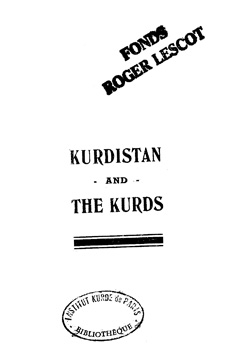| Éditeur : Compte d'auteur | Date & Lieu : , London |
| Préface : | Pages : 116 |
| Traduction : | ISBN : |
| Langue : Anglais | Format : 160x200 mm |
| Code FIKP : Lp. Gén. 63 | Thème : Général |
|
Présentation
|
Table des Matières | Introduction | Identité | ||
 Kurdistan and the Kurds | |||||
|
This report is an attempt to collect and edit all information at present available about the Kurds and Kurdistan. It is based on the reports of military and political officers, especially of Captain C. F. Woolley and Major E. Noel, and on a paper written by Sir Mark Sykes in 1908 on " The Kurdish Tribes of the Ottoman Empire." * The work of the" latter requires verification, as it is now nearly 15 years since he carried out his researches. The reports of the former are at present incomplete, as the country has only been accessible to British officers for six months. Chapter I Kurdistan and the Kurds § 1. The Country and its Boundaries Kurdistan embraces a wide tract of mountainous country, which bounds the fertile plains of the Euphrates and the Tigris on the north, almost from Aleppo to Lake Urmiyah, and on the east from Lake Urmiyah across the Persian frontier at Mendali to Pusht-i-Kuh. On the inner side of this half-circle the. frontiers of the country almost always coincide with the fringe of the low-lying plains and the skirts of the mountain-ranges; for the vast majority of the Kurdish tribes are mountain-dwellers and only descend to the plains at certain seasons of the year. On the outer edge, however, to the north and east, the limits of the country are less easily denned ; an almost countless horde of nomad and semi-nomad tribes move ceaselessly to and fro from mountain to valley and back again; small, unknown, tribes are settled more or less permanently wlierever a piece 'of land can be found suitable for cultivation; and all these Kurds are inextricably mixed up with Turkomans, Circassians, and Armenians; while religious differences form no less distinct divisions of these peoples than racial or national characteristics. ! Though, therefore, no definite! frontier can be traced, it can be said that Kurds predominate in all the country which is bounded on the south by the plains, and extends from Birijik, its westernmost extremity, northwards past Malatia almost to Erzing'an; thence the frontier runs along an ill-defined line to the river Araxes near Mount Ararat; from there it follows a southerly course past Lake Van to the north-west corner of Lake Urmiyah, and, skirting all the western shores of the lake, it passes down by Mundab to Khorsabad, and from there to Kermanshah ; and, finally, it bends round towards the east and strikes the plain of the Tigris at Mendali, on the Persian frontier, about 90 miles east-north-east of Baghdad. In the northern reaches of Kurdistan, however, we must except several clearly-marked stretches which are inhabited by peoples of a different race; Kharput is surrounded on the north, west, and south, entirely by Turks and Armenians; another large portion of Armenian territory encircles the town of Mush, though the city itself is occupied entirely by Kurds; round Lake Van is a wide belt of country populated exclusively by Armenians, and the western shore of Lake Urmiyah belongs equally to Turks, Armenians, and Kurds; and, lastly, another body of Armenians are settled in Julamerk and in the country west of the town, between these two lakes. Outside this area there are only a few unimportant colonies of Kurds, who have wandered away or been deported to Asia Minor or the Caucasus. | ||||